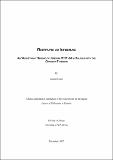Files in this item
Restitutio ad integrum : an 'Augustinian' reading of Jeremiah 31:31-34 in dialogue with the Christian tradition
Item metadata
| dc.contributor.advisor | Elliott, Mark | |
| dc.contributor.author | Moon, Joshua | |
| dc.coverage.spatial | 325 | en |
| dc.date.accessioned | 2008-02-12T13:29:22Z | |
| dc.date.available | 2008-02-12T13:29:22Z | |
| dc.date.issued | 2008-06 | |
| dc.identifier | uk.bl.ethos.552090 | |
| dc.identifier.uri | https://hdl.handle.net/10023/419 | |
| dc.description.abstract | The struggle to read Jer 31:31-34 as Christian Scripture has a long and divided history. Yet remarkably little has been done to grapple with the depth of this struggle in the Christian tradition from the post-Nicene period to the modern era. This thesis attempts to show the value of the tradition as an interlocutor for contemporary exegetical concerns in Christian readings and use of Jer 31:31-34. The study begins with Augustineâ s interpretation of the text as an absolute contrast between unbelief and faith, rather than the standard reading (found in Jerome) of a contrast between two successive religio-historical eras - one that governed Israel (the â old covenantâ ) and a new era and its covenant inaugurated in the coming of Christ. Augustineâ s absolute contrast loosened the strict temporal concern, so that the faithful of any era were members of the â new covenantâ . The study traces this reading of an absolute contrast in a few key moments of Christian interpretation: Thomas Aquinas and high medieval theology, then the 16th and 17th century Reformed tradition. The thesis aims at a constructive reading of Jer 31:31-34, and so the struggle identified in these moments in the Christian tradition is brought into dialogue with modern critical discussions from Bernhard Duhm to the present. Finally I turn to an exegetical argument for an â Augustinianâ reading of the contrast of the covenants. The study finds that Jer 31:31-34, read in its role in Jeremiah, contrasts Israelâ s infidelity with a future idyllic faithfulness to Yhwh: in the new covenant all will be as it always ought to have been. The contrast is thus between two mutually exclusive standings before Yhwh. Thus the study aims to contribute to modern exegetical, theological and ecclesial discussions of â oldâ and â newâ covenants by examining one of the central texts of the discussion in dialogue with parts of the history of interpretation. | en |
| dc.format.extent | 1989004 bytes | |
| dc.format.mimetype | application/pdf | |
| dc.language.iso | en | en |
| dc.publisher | University of St Andrews | |
| dc.rights | Creative Commons Attribution-NonCommercial-NoDerivs 3.0 Unported | |
| dc.rights.uri | http://creativecommons.org/licenses/by-nc-nd/3.0/ | |
| dc.subject | Jeremiah | en |
| dc.subject | Covenant | en |
| dc.subject | Augustine | en |
| dc.subject.lcc | BS1525.52M7 | |
| dc.subject.lcsh | Bible--O.T.--Jeremiah, XXXI, 31-34--Criticism, interpretation, etc. | en |
| dc.subject.lcsh | Augustine, Saint, Bishop of Hippo. | en |
| dc.subject.lcsh | Covenant theology--History of doctrines | en |
| dc.subject.lcsh | Bible--O.T.--Jeremiah--Commentaries--History and criticism | en |
| dc.title | Restitutio ad integrum : an 'Augustinian' reading of Jeremiah 31:31-34 in dialogue with the Christian tradition | en |
| dc.type | Thesis | en |
| dc.type.qualificationlevel | Doctoral | en |
| dc.type.qualificationname | PhD Doctor of Philosophy | en |
| dc.publisher.institution | The University of St Andrews | en |
This item appears in the following Collection(s)
Except where otherwise noted within the work, this item's licence for re-use is described as Creative Commons Attribution-NonCommercial-NoDerivs 3.0 Unported
Items in the St Andrews Research Repository are protected by copyright, with all rights reserved, unless otherwise indicated.


